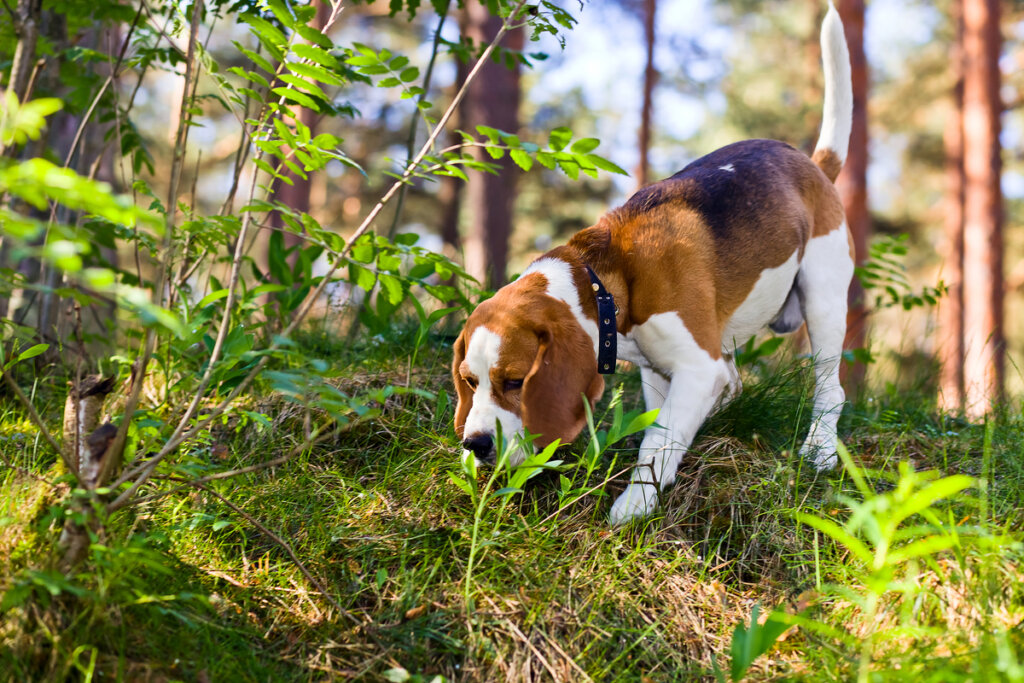What Your Dog Smells When It Goes for a Walk

Have you ever taken your dog for a walk, and seen it stick its nose in a bush and wondered what on earth it can smell to make it stay in the same place for so long? Well, this is quite normal, as its sense of smell is light years better than ours. Find out what your dog smells when it’s out and about in this article!
One of the reasons why a dog should go for a walk several times a day is because of the olfactory stimulation of leaving the house. In this article we’ll tell you what fascinates them so much, and why – don’t miss it!
The dog’s sense of smell

The first thing we need to do is to learn a little more about the sense of smell in dogs. From the outside in, dogs have 2 nostrils separated by a septum. This is where the animal draws air into its lungs. The first stop for that air, however, will be the nasal conchae or turbinates.
These anatomical structures contain the sensory cells that capture the particles contained in the air. From here run the nerves that reach the brain for the interpretation of these particles, creating the sensation of smell.
Surely you know that dogs have a better sense of smell than humans. This is due to a substantial difference: while humans have about 5 million of these cells, dogs have up to 220 million. In fact, if they were all laid out flat, they would occupy about 150 square meters (1600 square feet).
In addition, dogs have an olfactory cerebral lobe that’s much larger than a human’s, so they can process the smells around them in a much more complex way.
What your dog smells when it goes for a walk
With the above explanation, it’s clear that a dog’s main sense is its sense of smell. With it, they explore the world and communicate. That’s why it’s good to know what a dog smells when it goes for a walk, because it’ll tell us a lot about this sense and how they use it – something that’s hard for us to understand, as our sense of smell isn’t so developed.
Other dogs
You’ll have easily noticed that dogs greet each other by smelling their genitals, anus, and surroundings. This is because this area contains the perianal glands, two small sacs located on both sides of the anus that secrete a brown liquid that serves to lubricate the stools and facilitate their expulsion.
This liquid also contains information about the animal’s state of health, its sex, its sexual receptivity and even its age. All this is what dogs find out when they greet a new friend on the street.
The surroundings
Another of the things a dog smells when it goes for a walk are the neighborhood surroundings themselves. From the pheromone trail of an ant trail to the warm rubber of a car’s tires, the street is an endless source of olfactory stimulation for a dog.
This is one of the reasons why they should go outside, as mentioned at the beginning. It’s not just about exercise, but this constant stimulation, which gives them a natural sniffing behavior, is food for their mind. It keeps them active and improves their mental and emotional health.
Stools of other animals
Surely your canine companion has stopped more than once to smell some feces or a urine stain on a wall, even if it doesn’t belong to another dog. It’s logical, because these stools contain very interesting information for a dog: the species, sex, reproductive status, health, and even the identity of the dog who has done it.
This information is contained in the pheromones that are expelled with urine, feces and sweat, and dogs capture them thanks to the vomeronasal organ.

Sniffing and stress reduction
As already mentioned, when a dog sniffs all its surroundings while out for a walk it’s also receiving mental stimulation. However, through this behavior they’re also able to relax.
Have you ever seen your canine sniff the ground obsessively after a stressful time? They do it quickly, with their muzzle very close to the ground and don’t respond when you call them. This indicates anxiety.
However (and as long as a dog trainer doesn’t say otherwise) you shouldn’t prevent your dog from sniffing everything during a walk, as it helps them to control their stress. All that information they receive helps them not only to concentrate on something other than their anxiety, but also allows them to control their environment and feel safer. For this reason, let your dog sniff everything they want!
All cited sources were thoroughly reviewed by our team to ensure their quality, reliability, currency, and validity. The bibliography of this article was considered reliable and of academic or scientific accuracy.
- Mariño-Sánchez, F. S., Alobid, I., Rusiecka, M., Guilemany, J. M., & Mullol, J. Influencia del entrenamiento y la experiencia sobre el sentido del olfato.
- Horowitz, A., Hecht, J., & Dedrick, A. (2013). Smelling more or less: Investigating the olfactory experience of the domestic dog. Learning and motivation, 44(4), 207-217.
- Binks, J., Taylor, S., Wills, A., & Montrose, V. T. (2018). The behavioural effects of olfactory stimulation on dogs at a rescue shelter. Applied Animal Behaviour Science, 202, 69-76.